同步和异步
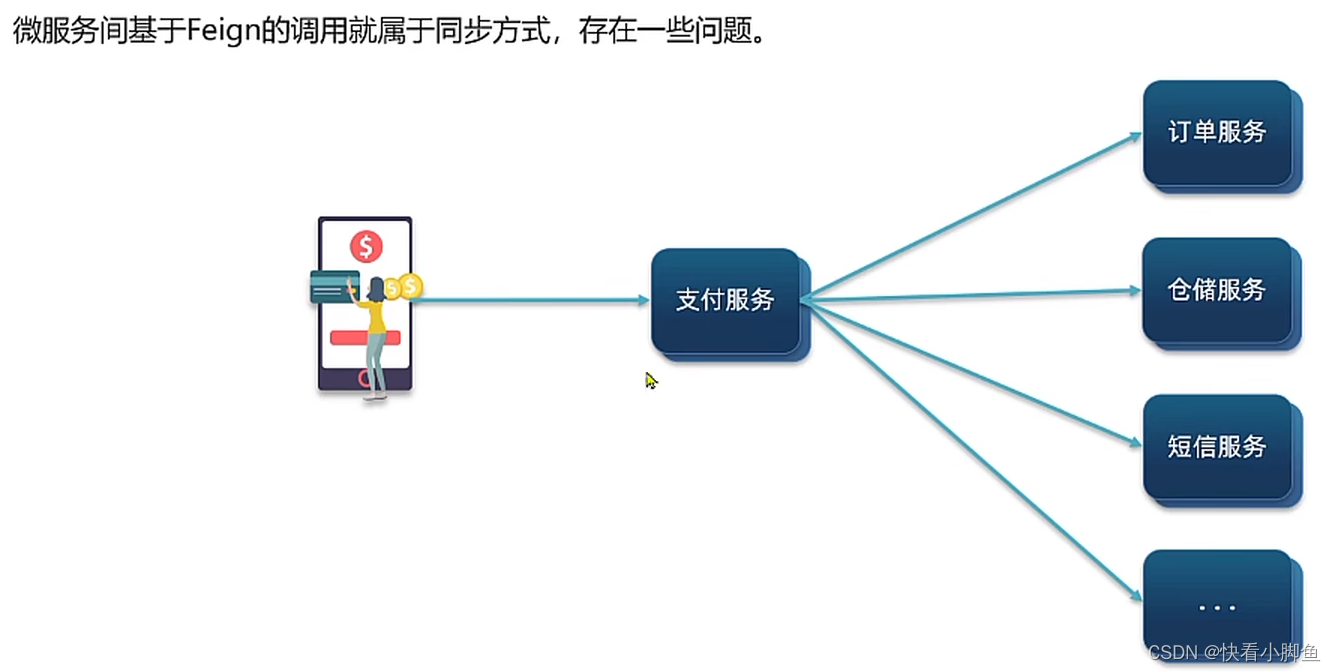
异步调用
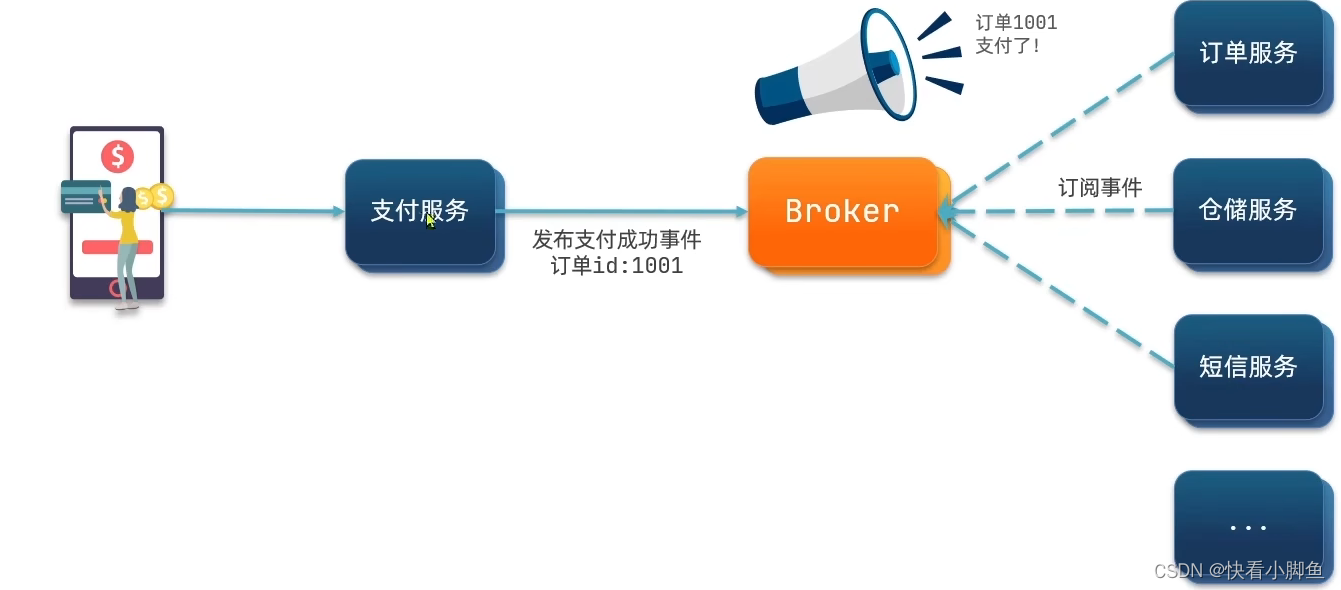
MQ
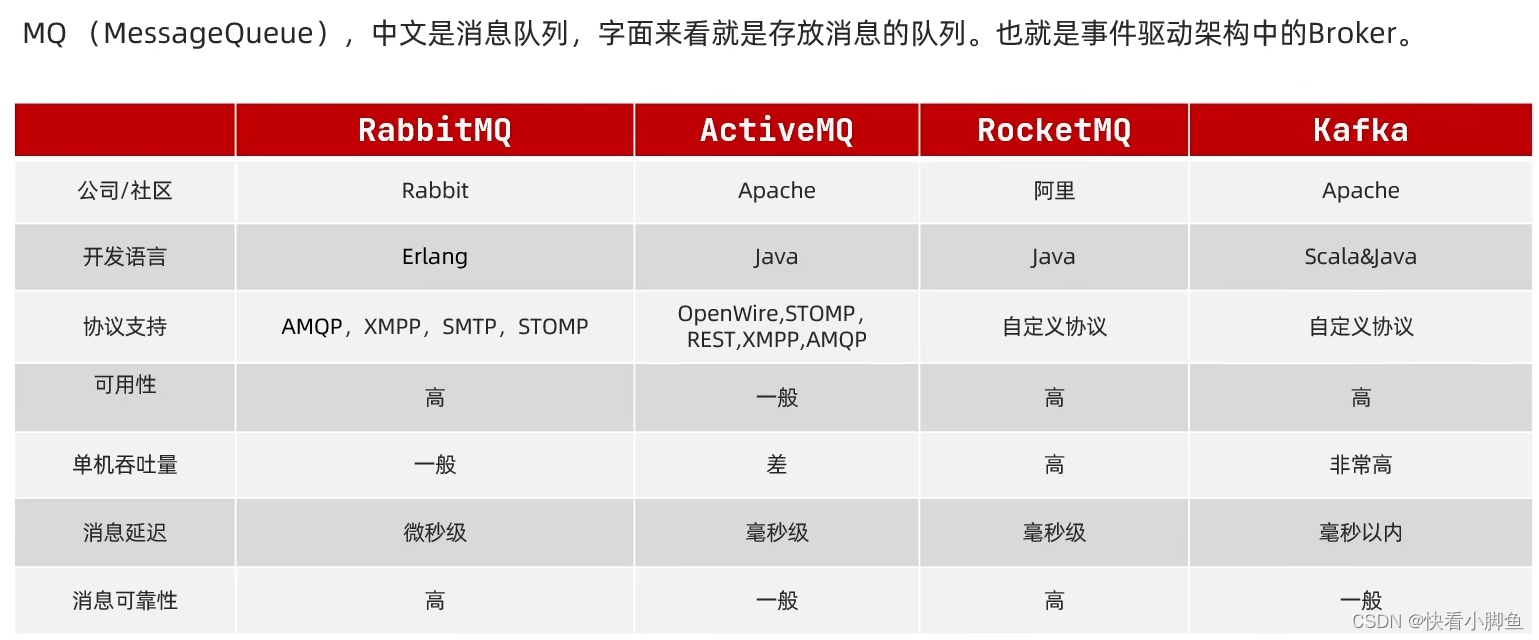
MQ优势:①服务解耦 ②异步调用 ③流量削峰
结构
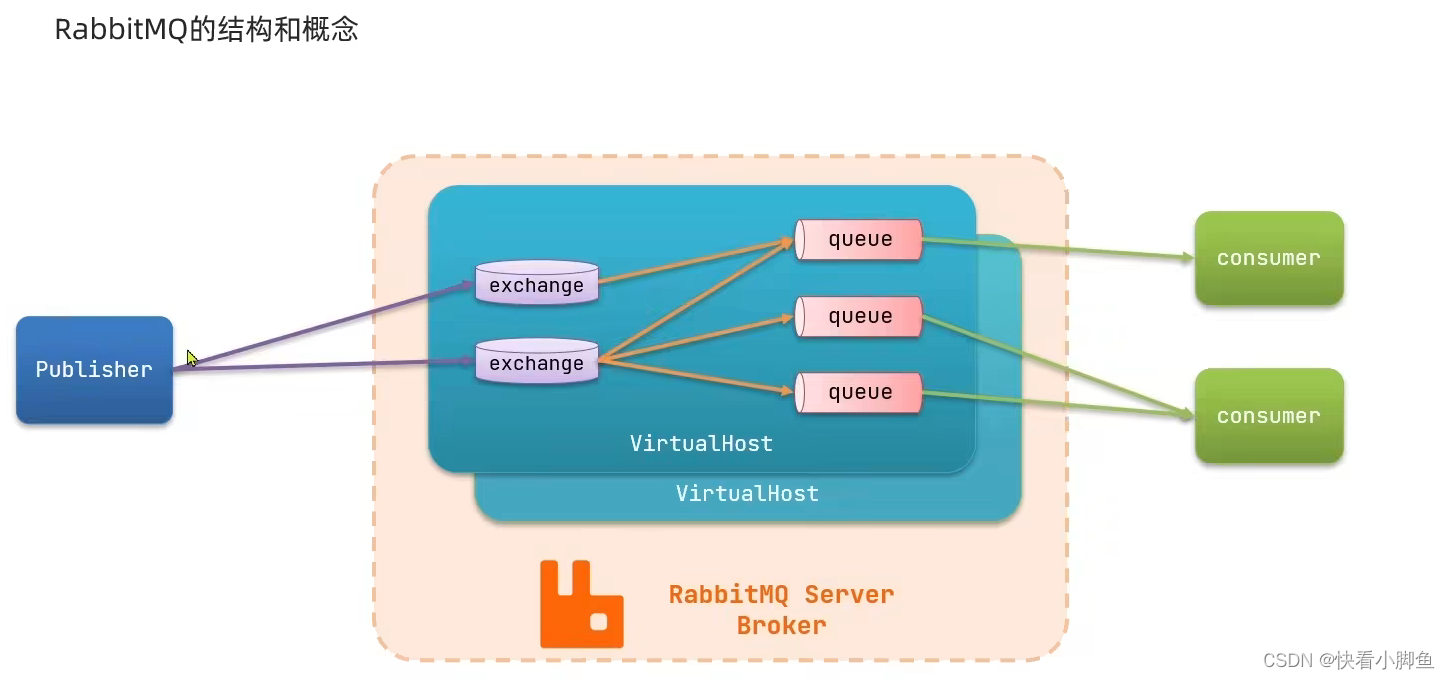

消息模型

RabbitMQ入门案例,实现消息发送和消息接收
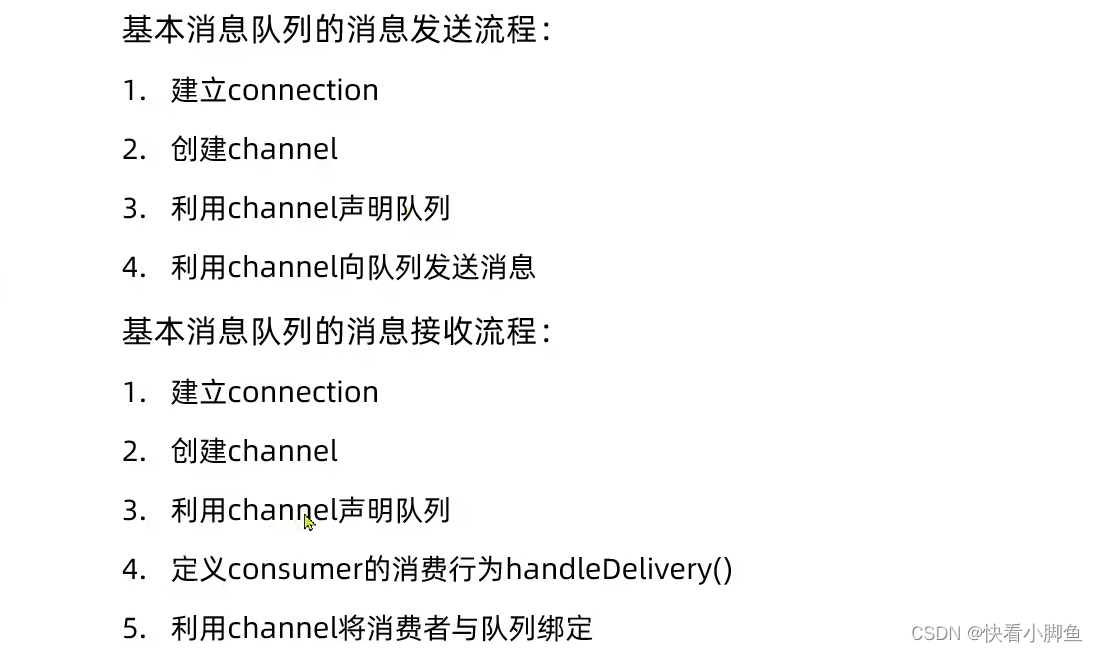
生产者:
public class PublisherTest {@Testpublic void testSendMessage() throws IOException, TimeoutException {// 1.建立连接ConnectionFactory factory = new ConnectionFactory();// 1.1.设置连接参数,分别是:主机名、端口号、vhost、用户名、密码factory.setHost("192.168.136.132");factory.setPort(5672);factory.setVirtualHost("/");factory.setUsername("itcast");factory.setPassword("123321");// 1.2.建立连接Connection connection = factory.newConnection();// 2.创建通道ChannelChannel channel = connection.createChannel();// 3.创建队列String queueName = "simple.queue";channel.queueDeclare(queueName, false, false, false, null);// 4.发送消息String message = "hello, rabbitmq!";channel.basicPublish("", queueName, null, message.getBytes());System.out.println("发送消息成功:【" + message + "】");// 5.关闭通道和连接channel.close();connection.close();}
}消费者:
public class ConsumerTest {public static void main(String[] args) throws IOException, TimeoutException {// 1.建立连接ConnectionFactory factory = new ConnectionFactory();// 1.1.设置连接参数,分别是:主机名、端口号、vhost、用户名、密码factory.setHost("192.168.136.132");factory.setPort(5672);factory.setVirtualHost("/");factory.setUsername("itcast");factory.setPassword("123321");// 1.2.建立连接Connection connection = factory.newConnection();// 2.创建通道ChannelChannel channel = connection.createChannel();// 3.创建队列String queueName = "simple.queue";channel.queueDeclare(queueName, false, false, false, null);// 4.订阅消息channel.basicConsume(queueName, true, new DefaultConsumer(channel){@Overridepublic void handleDelivery(String consumerTag, Envelope envelope,AMQP.BasicProperties properties, byte[] body) throws IOException {// 5.处理消息String message = new String(body);System.out.println("接收到消息:【" + message + "】");}});System.out.println("等待接收消息。。。。");}
}SpringAMQP

引入依赖
<!--AMQP依赖,包含RabbitMQ--><dependency><groupId>org.springframework.boot</groupId><artifactId>spring-boot-starter-amqp</artifactId></dependency>普通队列
第一步:publisher服务配置文件,发消息
spring:rabbitmq:host: 192.168.136.132port: 5672username: itcastpassword: 123321virtual-host: /@RunWith(SpringRunner.class)
@SpringBootTest
public class SpringAMQPTest {//获取RabbitTemplateAPI@Resourceprivate RabbitTemplate rabbitTemplate;@Testpublic void test(){String queueName = "simple.queue";String message = "hello SpringAMQP";//使用API传入队列名和消息即可直接发送rabbitTemplate.convertAndSend(queueName,message);}}
第二步:Consumer服务配置信息监听消息
spring:rabbitmq:host: 192.168.136.132port: 5672username: itcastpassword: 123321virtual-host: /import org.springframework.amqp.rabbit.annotation.RabbitListener;
import org.springframework.stereotype.Component;//定义一个监听类去监听消息
@Component
public class SpringRabbitListener {@RabbitListener(queues = "simple.queue")public void ListenSimpleQueue(String msg){System.out.println("msg = " + msg);}
}Work Queue队列
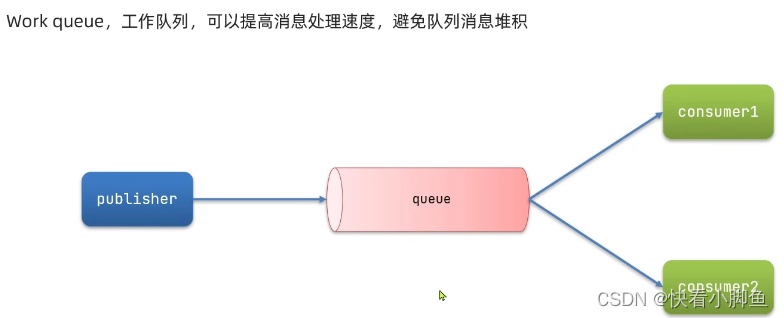
多个消费者绑定到同一个队列,可以通过prefetch来控制消费者消息预取的数量
第一步: 生产者发送消息
@RunWith(SpringRunner.class)
@SpringBootTest
public class SpringAMQPTest {//获取RabbitTemplateAPI@Resourceprivate RabbitTemplate rabbitTemplate;@Testpublic void test01() throws InterruptedException {String queueName = "simple.queue";String message = "hello SpringAMQP--";for (int i = 0; i < 50; i++) {//使用API传入队列名和消息即可直接发送rabbitTemplate.convertAndSend(queueName,message+i);Thread.sleep(20);}}}第二步:消费者设置多个监听消息
@Component
public class SpringRabbitListener {@RabbitListener(queues = "simple.queue")public void ListenWorkQueue(String msg) throws InterruptedException {System.out.println("消费者一接收到消息---- = " + msg + LocalDateTime.now());Thread.sleep(20);}@RabbitListener(queues = "simple.queue")public void ListenWorkQueue01(String msg) throws InterruptedException {System.out.println("消费者二接收到消息---- = " + msg + LocalDateTime.now());Thread.sleep(200);}
}
第三步:消费者可通过prehtch设置消息预取数量
spring:rabbitmq:host: 192.168.136.132port: 5672username: itcastpassword: 123321virtual-host: /listener:simple:prefetch: 1发布-订阅模型

Fanout广播交换机 --->多个队列收到交换机的消息
第一步:Consumer声明交换机,队列并进行绑定。
@Configuration
public class FanoutConfig {//声明交换机@Beanpublic FanoutExchange fanoutExchange(){return new FanoutExchange("itcast.fanout");}//声明队列1@Beanpublic Queue fanoutQueue1(){return new Queue("fanout.queue1");}//绑定队列1到交换机上@Beanpublic Binding fanoutBanding1(Queue fanoutQueue1,FanoutExchange fanoutExchange){return BindingBuilder.bind(fanoutQueue1).to(fanoutExchange);}//声明队列2@Beanpublic Queue fanoutQueue2(){return new Queue("fanout.queue2");}//绑定队列2到交换机上@Beanpublic Binding fanoutBanding2(Queue fanoutQueue2,FanoutExchange fanoutExchange){return BindingBuilder.bind(fanoutQueue2).to(fanoutExchange);}
}第二步:Consumer进行监听消息
@Component
public class SpringRabbitListener {@RabbitListener(queues = "fanout.queue1")public void ListenSimpleQueue1(String msg){System.out.println("消费者接收到fanout.queue1的消息 = " + msg);}@RabbitListener(queues = "fanout.queue2")public void ListenSimpleQueue2(String msg){System.out.println("消费者接收到fanout.queue2的消息 = " + msg);}
}第三步:Publisher向交换机发送消息
@RunWith(SpringRunner.class)
@SpringBootTest
public class SpringAMQPTest {//获取RabbitTemplateAPI@Resourceprivate RabbitTemplate rabbitTemplate;@Testpublic void testExchange() {//声明交换机名称String exchangeName = "itcast.fanout";//消息String message = "Hello Everyone";//发送消息rabbitTemplate.convertAndSend(exchangeName,"",message);}
}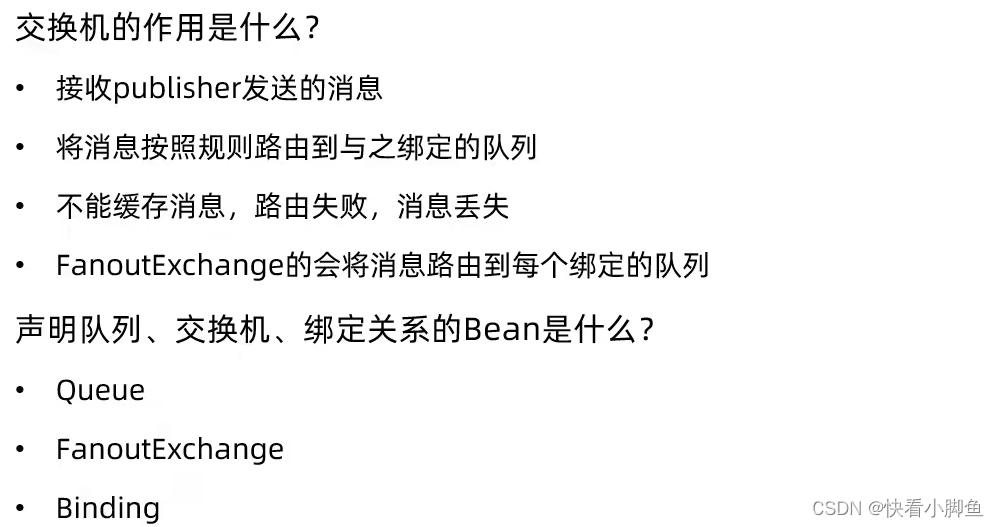
Direct路由交换机 --->将消息发给指定key的队列

第一步:在Listener中声明队列,交换机以及key
@Component
public class SpringRabbitListener {//声明队列1,交换机以及队列1的bindingKey@RabbitListener(bindings = @QueueBinding(value = @Queue(name = "derict.queue1"),exchange = @Exchange(name = "itcast.direct",type = ExchangeTypes.DIRECT),key = {"red","blue"}))public void ListenDirectQueue1(String msg){System.out.println("消费者接收到direct.queue1的消息 = " + msg);}//声明队列2,交换机以及队列2的bindingKey@RabbitListener(bindings = @QueueBinding(value = @Queue(name = "derict.queue2"),exchange = @Exchange(name = "itcast.direct",type = ExchangeTypes.DIRECT),key = {"red","yellow"}))public void ListenDirectQueue2(String msg){System.out.println("消费者接收到direct.queue2的消息 = " + msg);}
}第二步:向指定key的队列发送消息
@Testpublic void testDirect() {//声明交换机名称String exchangeName = "itcast.direct";//消息String message = "Hello Blue!!";//发送消息,指定交换机,队列以及要发送的keyrabbitTemplate.convertAndSend(exchangeName,"red",message);}Topic主题交换机 ---->key必须是多个单词列表,统一主题,支持通配符
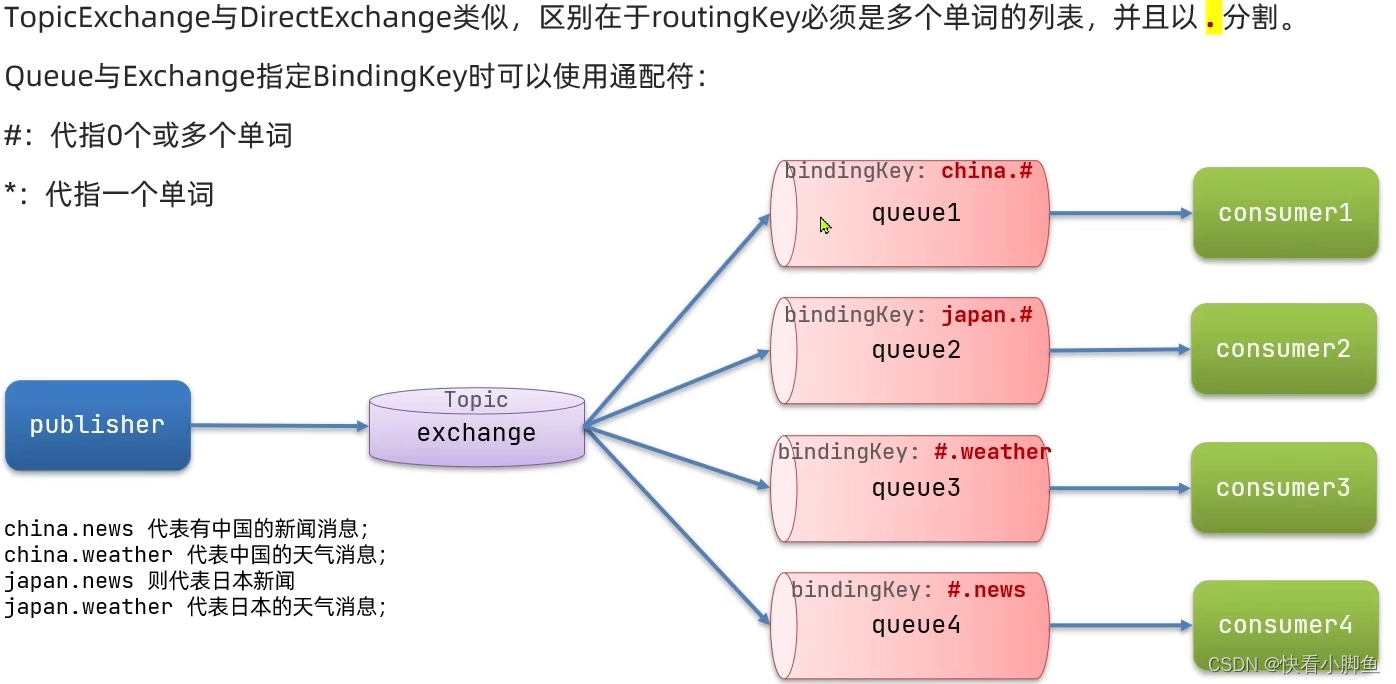
第一步:在Listener中声明队列,交换机以及通配符key
@Component
public class SpringRabbitListener {//声明队列2的交换机,队列以及通配符key@RabbitListener(bindings = @QueueBinding(value = @Queue(name = "topic.queue1"),exchange = @Exchange(name = "itcast.topic",type = ExchangeTypes.TOPIC),key = "china.#"))public void ListenTopicQueue1(String msg){System.out.println("消费者接收到topic.queue1的消息 = " + msg);}//声明队列2的交换机,队列以及通配符key@RabbitListener(bindings = @QueueBinding(value = @Queue(name = "topic.queue2"),exchange = @Exchange(name = "itcast.topic",type = ExchangeTypes.TOPIC),key = "#.news"))public void ListenTopicQueue2(String msg){System.out.println("消费者接收到topic.queue2的消息 = " + msg);}}第二步:向主题通配符发送消息
@RunWith(SpringRunner.class)
@SpringBootTest
public class SpringAMQPTest {//获取RabbitTemplateAPI@Resourceprivate RabbitTemplate rabbitTemplate;@Testpublic void testTopic() {//声明交换机名称String exchangeName = "itcast.topic";//消息String message = "Hello China!!";//发送消息rabbitTemplate.convertAndSend(exchangeName,"china.news",message);}
}消息转换器
RabbitMQ发的消息体都是Object类型,所有还可以发送对象数据。而且默认的消息转换器是MessageConverter实现的,当使用的是Map数据类型时,就会序列化成很多字节,所以推荐使用JSON的序列化和反序列化,直接修改默认的MessageConverter的类型
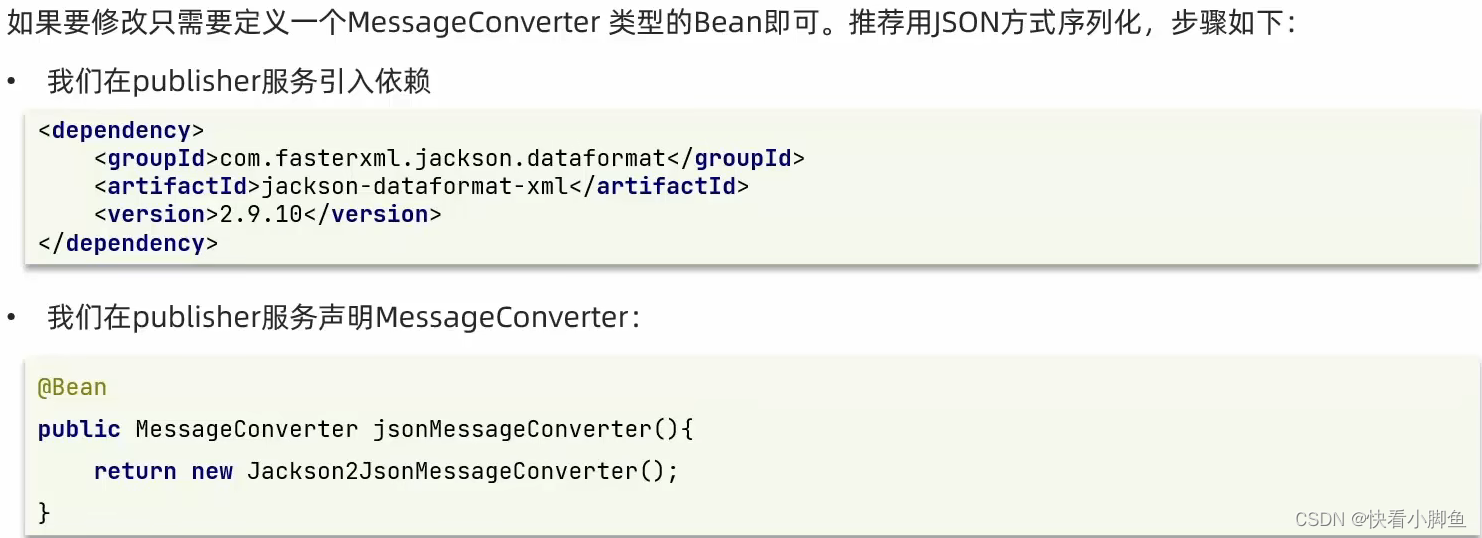
<dependency><groupId>com.fasterxml.jackson.core</groupId><artifactId>jackson-databind</artifactId></dependency>@Beanpublic MessageConverter messageConverter(){return new Jackson2JsonMessageConverter();}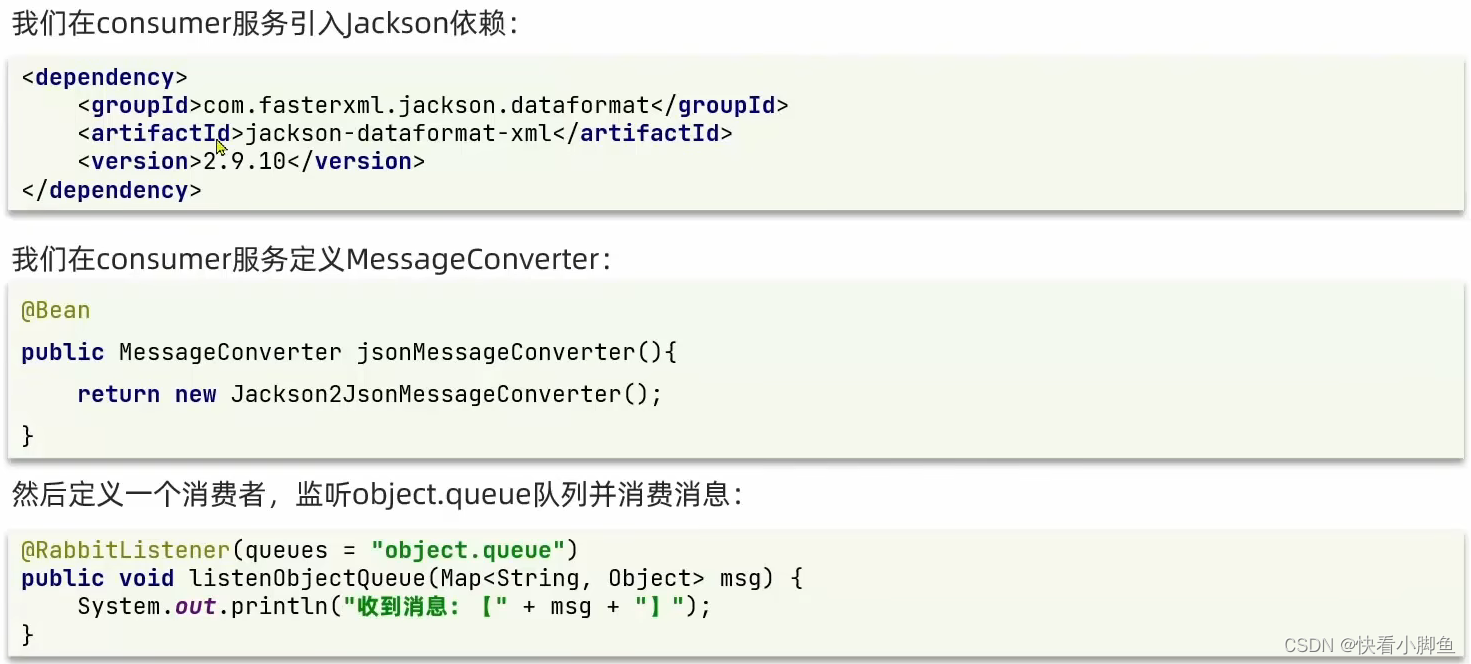
对于RabbitMQ高级部分:死信队列,延迟队列,发布确认,幂等性,优先,惰性队列等有时间再学

)










)




)

